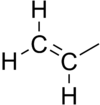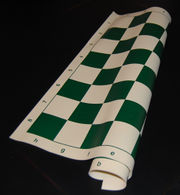Vinyl

A vinyl compound is any organic compound that contains a vinyl group (Preferred IUPAC name ethenyl).[1] Vinyl groups (formula −CH=CH2) are derivatives of ethene, CH2=CH2, with one hydrogen atom replaced with some other group. An industrially important example, is vinyl chloride, precursor to PVC, a plastic commonly known as "vinyl".

Vinyl groups are alkene derivatives: Primary alkenes are made of vinyl groups. On a carbon skeleton, sp2-hybridized carbons or positions are often called vinylic. Allyls and acrylates contain vinyl groups.
Contents |
Etymology
The etymology of vinyl is the Latin vinum = "wine", because of its relationship with alcohol (in its original sense of ethyl alcohol).
Related to vinyl compounds are vinylidenes. Vinylidene itself, a rare species of theoretical interest, is a modified carbene with the formula CH2=C:.[2] Vinylidenes describe compounds containing the functional group CX2=C. For example, 1,1-dichloroethene (CH2=CCl2) is called vinylidene chloride.
Vinyl and vinylidene polymers
Vinyl groups can polymerize, forming vinyl polymers. In these polymers, the double bonds of the vinyl monomers turn into single bonds and the different monomers are joined by single bonds. Vinyl groups do not exist in vinyl polymer, the term refers to the precursor. It is sometimes important to ascertain the absence of unreacted vinyl monomer in the final product when the monomer is toxic or reduces the performance of the plastic. The following table gives some examples of vinyl and vinylidene polymers.
| Monomer type | Monomer example | Example of resulting polymer |
|---|---|---|
| Vinyl | Vinyl chloride | Polyvinyl chloride (PVC) |
| Vinyl fluoride | Polyvinyl fluoride (PVF) | |
| Vinyl acetate | Polyvinyl acetate (PVAc) | |
| Vinylidene | Vinylidene chloride | Polyvinylidene chloride (PVDC) |
| Vinylidene fluoride | Polyvinylidene fluoride (PVDF) |
Reactivity
Vinyl groups are alkenes. If activated by an adjacent group, the increased polarization of the bond gives rise to characteristic reactivity, which is termed vinylogous:
- In allyl compounds, where the next carbon is saturated but substituted once, allylic rearrangement and related reactions are observed.
- Allyl Grignard reagents can attack with the vinyl end first.
- If next to an electron-withdrawing group, conjugate addition (Michael addition) occurs.
Vinyl organometallics, e.g. vinyl lithium, participate in coupling reactions such as in Negishi coupling.
See also
- Acetylenic
- Allylic/Homoallylic
- Benzylic
- Propargylic/Homopropargylic
- Vinylogous
References
- ↑ IUPAC Provisional Recommendations 2004 Chapter 5
- ↑ http://goldbook.iupac.org/V06623.html